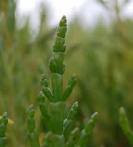Bugle is closely related to Self-Heal, (Prunella vulgaris), and has similar healing properties. They are both used for healing wounds and are both in the mint or Labiatae or Lamiaceae family of plants. Bugle flowers between April and the end of June and is indigenous to Europe , including the British Isles , North Africa and parts of Asia . Having been brought from Europe to America
The old herbalists had a very high opinion of bugle and held it in as much esteem as Self-Heal, with John Gerard, the 16th century herbalist having this to say about it:-
 “There is not a better Wound herb in the world than that of Self-Heal…for this very herbe, without the mixture of any other ingredient, being onely bruised and wrought with the point of a knife… will be brought into the form of a salve, which will heal any green wounde…The decoction of Prunell made with wine and water doth join together and make whole and sound all wounds, both inward and outward, even as Bugle doth. To be short, it serveth for the same that the Bugle serveth and in the world there are not two better wound herbs as hath been often proved.”
“There is not a better Wound herb in the world than that of Self-Heal…for this very herbe, without the mixture of any other ingredient, being onely bruised and wrought with the point of a knife… will be brought into the form of a salve, which will heal any green wounde…The decoction of Prunell made with wine and water doth join together and make whole and sound all wounds, both inward and outward, even as Bugle doth. To be short, it serveth for the same that the Bugle serveth and in the world there are not two better wound herbs as hath been often proved.” '…if the virtues of it make you fall in love with it (as they will if you be wise) keep a syrup of it to take inwardly, and an ointment and plaster of it to use outwardly, always by you. The decoction of the leaves and flowers in wine dissolveth the congealed blood in those that are bruised inwardly by a fall or otherwise and is very effectual for any inward wounds, thrusts or stabs in the body or bowels; and is an especial help in wound drinks and for those that are liver-grown, as they call it. It is wonderful in curing all ulcers and sores, gangrenes and fistulas, if the leaves, bruised and applied or their juice be used to wash and bathe the place and the same made into lotion and some honey and gum added, cureth the worse sores. Being also taken inwardly or outwardly applied, it helpeth those that have broken any bone or have any member out of joint. An ointment made with the leaves of Bugle, Scabious and Sanicle bruised and boiled in hog's lard until the herbs be dry and then strained into a pot for such occasions as shall require, it is so efficacious for all sorts of hurts in the body that none should be without it.'
(Sanicle mentioned above is Sanicula Europea (LINN).)
Bugle has been used in traditional medicine for coughs, the treatment of tuberculosis, a heart tonic, and to help wean babies from their mother’s breast milk by reducing the flow of milk. In some countries it has been used in intermittent fevers such as malaria, as a diuretic and to relieve nausea and bilious attacks. It has been used to combat hallucinations caused by excessive ingestion of alcohol as it reportedly has mildly narcotic sedative effects.
 It contains flavonoids, glycosides, volatile oil and tannins and several other substances including a phenylpropanoid, teupoliside which has been investigated by a team led by Dr. Salvatore Cuzzocrea of the
It contains flavonoids, glycosides, volatile oil and tannins and several other substances including a phenylpropanoid, teupoliside which has been investigated by a team led by Dr. Salvatore Cuzzocrea of the A tisane can be made with 1 ounce of the dried (whole) herb to one pint of boiling water, steeped for 15 minutes before straining. This is for internal haemorrhaging and to stop the coughing up of blood, traditionally. It is supposed to be a hangover cure too, but the herb lowers the pulse rate and has similar properties to digitalis which is extracted from foxglove.
Bugle has been substituted for Self-Heal in traditional medicine, but very little research has been conducted on this herb. The traditional uses for it have not been verified or refuted by clinical trials.
























